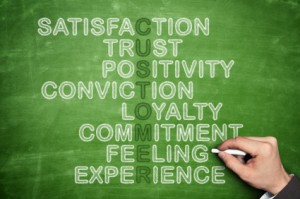The Importance Of Customer Experience For B2B Relationship
The Importance Of Customer Experience For B2B Relationship
Efficiency, service, quality, and reliability…
These are just a few of the terms we often hear when discussing the topic of customer satisfaction. Most businesses understand that retaining customers is a fine art that requires a well defined process.
Oftentimes, we see that a basic framework for customer experience is built at the beginning of an organization’s founding and once built, time and resources are pulled away and reallocated to other areas of the business leaving the skeleton framework to run itself. However, successful businesses understand the value in continuing to measure and optimize and grow their approach towards enhancing the customer experience.
One of the best ways to optimize your customer experience and retain customers is by collecting data from customer satisfaction surveys, or by using the Net Promoter Score (NPS) process. The Net Promoter Score (NPS) is a simple but powerful tool to measure client satisfaction with one single question, an indication of the growth potential of your company or product.
Marketing research, focus groups, and client satisfaction surveys are oftentimes polarizing topics. However, it is our belief that the data you collect is always less scary than the data you ignore. We would argue that the benefits far outweigh the negatives when implementing a customer satisfaction (CSAT) survey.
First and foremost, simply giving your customers or clients an avenue to voice their feedback goes a long way. Sure, any major issues or problems can be communicated on a daily basis without a survey, but an effort like this allows customers and your company to take a step back and think about larger themes and strategies outside daily minutiae. A good analogy is playing football everyday on the field focusing on one play at a time, versus stepping back and viewing plays from the booth. You need to spend time doing both, and we all get so busy worrying about the little things that we forget about the big ones.
When organizing a customer satisfaction survey, here are some items to consider:
We will dive deeper into each point below:
5 basic aspects:
- Who should be interviewed?
- What needs to be measured?
- How should the survey be carried out?
- How should customer satisfaction be measured?
- How to use the results to increase satisfaction, loyalty and profitability.
Who Should Be Interviewed?
When it comes to the target audience for our survey, we must consider the big picture. Take, for example, a truck manufacturing company. Who should be interviewed? The driver, the transport manager, the general management of the company? Similarly, in other b2b markets there may well be influences on the buying decision from production, QA’s, research, engineering or development staff. Because each department evaluates suppliers differently, the customer satisfaction survey will need to expand and shift to cover the multiple views.
What Should Be Measured?
In researching the satisfaction level of our customers, we are searching to uncover the respondents’ view on a variety of categories that will help us identify how the company is currently performing and how we can improve in the future. This understanding is obtained at a high level (“how satisfied are you with Lead liaison overall?”) and at a very specific level (“how satisfied are you with the clarity of invoices from Lead liaison?”).
How Should The Interview Be Carried Out?
While customer surveys are important, there are other indicators to help measure your customer experience. Sales volumes from cross-selling are a great indicator, but they can fluctuate for many other reasons beyond customer satisfaction. In addition, the complaints you receive from customers speak volumes, but they may also reflect the views from a more narrow portion of your clientbase. Positive words relayed through an email or spoken out loud during a conference call are also worthwhile indicators, and should be noted. However, each of these haphazard pieces on their own are not enough to provide understanding on a higher level.
We believe that you must tie it all together by using several different tools in a very intentional way. The toolkit for measuring customer satisfaction boils down to three options, each with their advantages and disadvantages:
- Online Surveys
- Face-to-Face Interviews
- Phone Conversations
How Should Satisfaction Be Measured?
Customers may express both their satisfaction & unhappiness in a variety of ways. The best thing to do is to be intentional about asking for their opinion.
By using the basic concept of the NPS survey, your customer can accurately relay their happiness by rating you using a concept they are familiar with – Numerical Scoring. Once the respondent has been given the anchors of the scale, they can readily give a number to express their level of satisfaction. Typically, scales of 5, 7 or 10 are used where the lowest figure indicates extreme dissatisfaction and the highest shows extreme satisfaction.
Developing An Action Plan That Rectifies The Weaknesses And Builds On The Strengths
The purpose of customer satisfaction research is to improve customer loyalty, and yet so often surveys sit collecting dust. Worse than that, customers have generously given their time to assist in the customer satisfaction survey believing that some positive action will take place. Their expectations will have been raised. The process of collecting the data seems easier than taking action to improve satisfaction levels.
- Spot the gap
- Challenge and redefine the segmentation
- Challenge and redefine customer value propositions, customer journeys and understanding of customer needs
- Create an action plan
- Measure and review
In conclusion, implementing this type of survey is one of the best ways to continue to build on your customer experience framework. You must remember, however, that customer satisfaction indexes are a snapshot at a point in time. People’s views change continuously and the performance of companies in delivering customer satisfaction is also changing. Measuring satisfaction must be a continuous process. Whether you offer a reward, such as a coupon for a free e-gift card, or customers complete your survey without prompting, be prepared to dig far enough that you discover information that can require anything from a mere tweak in company policy to a complete change in your operating paradigm.
Lead liaison is a multifunctional event platform that provides: Universal Lead Capture, User Customizable Gamification, Marketing Automation, CRM, Lead Management, Sales Enablement, Leader Boards, Point Rewards & e-Gift Cards, Waypoints for Sessions & Scavenger Hunts, Player Profiles, and more with over 3,000 integrations for all common CRM and Marketing Automation platforms.
To see how Lead liaison’s growing library of digital activations (games), universal lead capture, and reward-based solutions can help your company generate more leads at your trade shows, contact us today!




